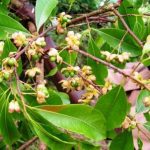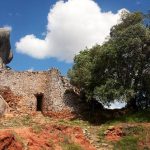TREE LIFE
January 1986
Your committee trust that 1985, has been a happy year and wish our members all the best for 1986 – may it be a year of peaceful botanizing – Kim, Phil, Meg, Pat, Georgie, Molly, Marjorie, Barbara and Margaret.
HARARE CALENDAR
Tuesday January 7th : Botanic Garden Walk.
Sunday January 19th : “Pentland”, the Waddell’s Farm, Mazowe. Meg was very taken with the area after a rewarding reccce, so it promises to be an interesting outing. A few of the species which we seldom see include Olea europaea, Schrebera alata, Acokanthera oppositifolia and even possibly Ekebergia capensis. We will travel in our own cars again and so meet at Monomatapa Car Park at 0830 to arrange lifts.
MATABELELAND CALENDAR
On Sunday January 5th we will go to the Helensvale Block. Meet at Mr. Sykes’ House, 1 Founders Road, Richmond, at 0830 hours.
On Sunday December 1st we went to the Hillside Dams near the Aloe Garden Car Park. We were delighted to see some of our invalids back, and making good progress. WE saw some 45 different species including Acacia galpinii, Acacia karroo, Acokanthera rotundifolia, Albizia amara, Albizia antunesiana Azanza garckeana, Berchemia zeyheri, Brachylaena rotundata, Canthium lactescens, Carissa edulis, Cassine transvaalensis, Celtis africana, Clerodendrum glabrum, Commiphora schimperi, Croton gratissimus, Cussonia natalesis, Diospyros lycioides, Dovyalis caffra, Ehretia rigida, Fagara capensis, now zanthoxylum, Ficus ingens, Ficus natalensis, Ficus sur Maytenus senegalensis, Maytenus undata, Olea europea subsp. africana, Ozoroa insignis subsp.reticulata, Pappea capensis, with very varied leaves, Pavetta gardenifolia, Rhoicissus tridentata, Rhus lancea, Schrebera alata, Securidaca longepedunculata, Securinega virosa, Strychnos spinosa, Vangueria infausta.
-C.Sykes
BOTANIC GARDEN WALK, 3RD DECEMBER 1985 : THE BURSERACEAE
Once again Tom Muller led us into the Sapindales an order which we have learned to associate with imparipinnate compound leaves such as those of Bersama, MELIANTHACEAE, the SAPINDACEAE, the marula, ANACARDIACEAE, Kir
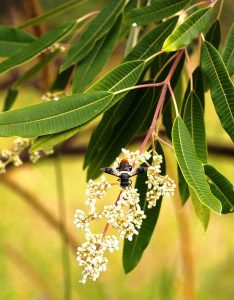
Ozoroa longepetiolata. Photo: Bart Wursten. Source: Flora of Zimbabwe
The BURSERACEAE are most at home in hot dry habitats such as the S E Lowveld and Zambezi Valley and are generally characterized by resins in the bark. Some of these resins are aromatic and include myrrh, frankincense and the balsam of Gilea which have been collected for many centuries fro plants in the hot Midle East. If Tom finds bright red slashes they remind him of Parisien ladies the Shulommite maiden in the Song of Solomon compared the lips of her shepherd lover to a gashed Commiphora which is found “dripping with liquid myrrh” (Canticles 5:13). In time myrrh hardens and may be collected as a red brown resin which the same maiden was equally taken with and described how this too reminded her of her lover, (Canticles 1:13). The hard resin from Boswellia carteri was ground and then thrown into a fire as a superior quality = frank incense, or frankincense. We may remember that Joseph was sold to the Ishmaelite traders who were on their way to Egypt with “balsam and resinous bark” from Gilead. This balsam of Gilead was the resin from Commiphora opobasamum. Similar resins and balms also occur in other members of the Sapindales. Mastic is a resin from Pistacia, an ANACARDIACEAE and the resins in the bark of Ozoroa longepetiolata are in great demand by local nyangas.
The aromatic oils in the citrus family RUTACEAE, are well known to us all.
Prof. Wild summed up the species of Commiphora when he stated “leafless for the greater part of the year”. This makes identification by leaf impractical but looking at them in December enabled us to compare leaves flowers and bark features together but we tried to concentrate on the less temporal features.
We have fifteen indigenous Commiphora species and six of them have spine tipped branches. One species, C.mollis, sometimes has spines. As a feature, spines work well on condition they are felt and not simply seen. The branches of C.caerulea look spiny but no point can be felt. The spiny species are more confusing than the others and include C.merkeri, C.neglecta, C.ugogensis, C.pyracanthoides, C.africana and C.schimperi. On slashing the specimens in the Botanic Gardens only two of these six exuded a white milky say these were C.merkeri and C.ugogensis. C.neglecta, C.pyracanthoides and C.schimperi exuded a clear resin and nothing was produced by C.africana. It would be interesting to hear if this works in the field although Brian Best tells me that during the dry season squeezing sap out of a tree is like getting blood out of a stone. I would be particularly interested to hear how the Bulawayo folk identify their species in the dry season.
The bark of C.merkeri has zebra stripes with smooth areas alternating with tufts. These show up well on Tom’s specimens which are only waist high, although apparently smaller specimens can be more of a problem. The young branches are smooth and purplish and this distinguishes it from other spiny species. C.merkeri often grows in mopane woodland in the Zambezi Valley or around Birchenough Bridge where it may occur along with C.pyracanthoides and C.caerulea.
We had actually started the walk by looking at the C.ugogensis that is alongside a large rock south of Tom’s Gardenia resiniflua. The trunk of C.ugogensis has fine peels which reveal the green under bark. It still seems very similar to C.pyracanthoides and C.africana to me but perhaps the presence of white ilk may help. C.ugogensis grows on deep sands in the Zambezi Valley and occasionally o rocky outcrops. In the jesse thicket they are severely hammered by the elephant. I hasten to add that in leaf the Commiphora species are no great problem, C.ugogensis has compound leaves, those of C.africana are trifoliate and C.pyrocanthoides are simple!
We found the C.pyracanthoides closer to the herbarium and across the lawn from Grewia occidentalis. Without the simple leaves I am a bit lost on this specimen although the spines were pronounced and the peels larger than C.ugogensis or C.africana. As we wandered towards the Colophosperum patch Tom confessed to once having collected what he thought was a small leafless Commiphora and planted it today it grows as a large Steganotaenia alongside the C.africana. The C.africana has fine peels and a green under bark as well but we do see it here around Harare Tom speaks of a smaller variety which ever exceeds a meter or so in mopane vegetation. C.africana is common amongst rocks throughout Zimbabwe.
In the thicket behind the C.africana we crept underneath shrubs and ginger bushes to find C.schimperi with its small trifoliate leaves and another trunk of brown peels and green under bark. This species grows in the S E Lowveld and around Victoria Falls. We only saw C.neglecta much later on in the walk over in the S E Lowveld section beyond the Monodora. This species is apparently common around Maputo but extends into the S E of Zimbabwe around Chisumbanje. The peels resembled those of C.marlothii.
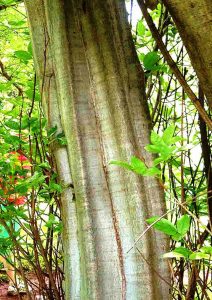
Commiphora karibensis. Photo: Rob Burrett. Source: Flora of Zimbabwe
Two of the rest of the species, C.mollis and C.karibensis, have branches which look as if they have been pushed into the trunk which has then wrinkled like half set toffee. Both trees develop a grey, angular trunk although this is often more pronounced in C.karibensis. In the botanic gardens a milky sap can be elicited from C.mollis but not C.karibensis this latter species does have a copious flow of transparent resin. Although their general distribution overlaps, both Tom and Colin Craig from Sengwa Research, assure me they can be separated on habitat. C.mollis tends to have a bark which is less smooth and it grows on hillsides rocky slopes or anthills whereas C.karibensis is often smoother and darker and is most often encountered in jesse thicket where elephant damage it quite severely. Tom has both trees growing side by side in the Commiphora section alongside the Zambezi Valley Section.
Next to these species we found two of the three paper bark Commiphora species with very large peels. The first, C.angolensis, has a cloudy sap and only grows on Kalahari sands. The under bark is green like that of C.marlothii which we find in rocky outcrops and on the escarpment slopes, and see often on our trips. We found this species behind the Aloe bainesii. Alongside the C.angolensis was the attractive C.caerulea with its cerulean L.caeruleus sky-blue, under bark. This species grows with Kirkia in the Zambezi Valley on deep soils or rock slopes its slash produced a transparent resin whereas C.marlothii produces white milk.
The last four species are all individually distinctive. C.mossambicensis has a rich deep honey coloured trunk with a transparent sap in the bark, but a milky exude from the wood. This has a pepper smell, like that of the leaves. The compound leaf has 3 to 5 leaflets which each resemble an apricot leaf. It is common on hillsides at lower altitudes and Tom’s specimen hides behind the C.africana.
The C.zanzibarica alongside the C.ugogensis was covered in long sprays of small flowers. It does not look particularly like a Commiphora with sooth grey bark but it was the only species to exude a yellow sap from the slash. Its bark may reflect its more mesic habitat in riverine forest or along dry river courses.
Tom was not very pleased with the shape of his C.edulis which was somewhat elongate, but it did show the pale grey flaking bark ad big furry leaflets. These trees develop a globular shape in the south of the country around Birchenough Bridge area where they grow I ay of the river valleys.
The last specimen we examined alongside the Grewia caffra was C.tenuipetiolata which was too small to see the brown flakes to the bark. This is common on hillsides on the road to Messina and has a trifoliate leaf.
We must thank Tom once again for the walk, and would value some field comments from readers as to how they tell a number of the species apart in their local area. It would also be worthwhile examining to see if the slash colour does work in the field.
-Kim ST.J.Damstra
SOCIAL TREE DAY – SUNDAY 8TH DECEMBER 1985
Meg Coates Palgrave very kindly offered her house for our December “social” when in lieu of a formal outing we gather to exchange greetings, gossip, eat, dandle babies and look at a few trees as well.
Having gathered in Meg’s open air conservatory we were treated to a scrumptious tea which included, of course, mince pies. After much gossiping the very pleasing turnout headed out on foot across or rather under, Glenara Drive and found its way into the south west corner of the Mukuvisi Wodlands. On the long walk before crossing the river attention was drawn to the many Acacia rehmanniana in flower. On the lee side of each tree the scent was very alluring. Although superficially similar to Acacia karroo due to the rusty coloured branchlets, they are very different, with superfine leaflets and white rather than yellow flowers.
I missed many details of this walk owing to child carrying duties, I carefully avoid child bearing duties that is Cheryl’s job, so I will merely comment on the highlights. Being the right time and right place the ground was littered with a number of different ground orchids, the names of which escaped me, but wandering over to a low anthill we found an unusually large Euclea divinorum and in its shade were an Ehretia amoena and a Maerus triphylla. This is a member of the CAPPARACEAE which often have digitately compound leaves, this specimen often had five rather than three leaflets.
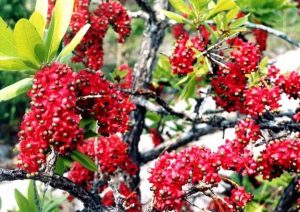
Ochna pulchra. Photo: Jos Stevens. Source: Flora of Zimbabwe
The most interesting phenomenon of the day, and which had Meg bubbling over with excitement were the “peeling roots” of Ochna pulchra. Most of us are familiar with the mermaid skin which flakes in characteristic fashion to reveal a smooth under bark. But I doubt that any of us were aware that this flaking extended to the roots. The erosion of soil away from the roots on a well worn footpath had led to this discovery. Aside from a mature adult tree we found a few small specimens which looked little more than seedlings, until one realized that they, too, had veritable tree sized roots! Being in a small group not far from adult trees, we speculated as to whether these small trees were indeed seedlings, or whether perhaps the ad “suckered” from lateral roots of the adult tree.
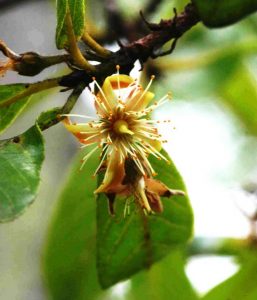
Monotes glaber. Photo: Bart Wursten. Source: Flora of Zimbabwe
It was in these woodlands that I was first shown Monotes glaber with its characteristic gland at the base of the leaf. So it was perhaps appropriate that it was again in the woodlands that I was now first shown the tree in flower. Though the flowers are not showy, they are not unlike those of Ochra. Kim noted that the OCHNACEAE and DIPTEROCARPACEAE, of which Monotes is a member, are closely related families and this is also reflected in the fact that in both Ochra and Monotes the sepals are persistent below the fruiting carpals, and in totally different ways achieve the common goal, of seed dispersal. In Ochra the sepals remain fleshy and colourful to attract the attentions of birds, while in Monotes the persistent sepals develop into light dry helicopter rotors for east wind dispersal.
En route back our tired eyes were rewarded with the first sighting this season of Pterocarpus rotundifolius in flower. The flowering times of this tree seem to be over a protracted period but are triggered by showers of rain, so having flowered and then gone into recess a shower of rain will prompt a new flowering session a day or two later.
Lunchtime found us back at Meg’s house where thirsty throats were slaked and hungry mouths filled with our picnic lunches. After more chit chat, renewed acquaintances, etc, the happy throng in due course dispersed.
Thank you Meg for all your efforts in making this such a successful and happy day, and Bon Voyage to the UK and Europe.
-J.P.Haxen
ROOTNOTE : We have taken a great interest in extra floral nectarines and their possible significance and so in August I was most excited to come across a young tree in the Nyamoumba River bed, Zambezi Valley, which was precariously poised amongst sand and rocks. Here amongst the fresh leaves were pairs of large, 2cm long and almost as wide, stipule like structures which were covered in numerous crater like glands that had attracted many ants. Unfortunately the leaves on this BIGNONIACEAE were soft and fell apart in the press. On my return I carefully examined all the BIGNONIACEAE in the Botanic Gardens, none have stipules, not Fernandoa, Markhamia, Kigelia nor Stereospermum. Not even when the leaves were very fresh and new. Just when the search was roving fruitless we arrived at the Carter’s gate on our November outing and here they have planted two Kigelia africana, both of which are still young and apparently struggled through the drought. Both trees had the large stipules, and the glands, and attracted many ants. Prof. Phelps of the University recently revisited the Zambezi Valley located the tree I had originally found and returned with branches of leaves, still with the glands and stipules, apparently still covered in ants and identified positively as Kigelia afriana. Is it significant that the glands are on young trees in stressed environments and not on older trees? Are the glands functional in that they attract ants which may protect the tree against damage from caterpillars for example? It is also interesting that all references I could find state that the BIGNONIACEAE lack stipules, yet we have seen other stipules on other members of this family.
-Kim ST.J.Damstra
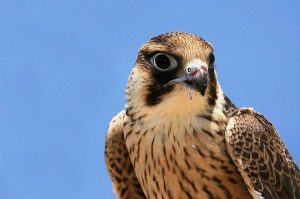
Lanner Falcon, Falco biamicus, Photo: Wikipedia
ROOT NOTE: George Hall has been watching the Lanner Falcon, Falco biamicus, on Earl Grey Building and with his usual curiosity collected disgorged pellets and noted the large numbers of seeds which they contained. These pellets were planted in sterile soil under controlled conditions which prevented contamination of the soil by other seeds. The following seedlings were identified Cleome monophylla, an annual weed in the CAPPARACEAE, Eleusine indica, Rapoko grass, Ficus thonningii, F.vogelii, Graphalium pennsylvanicum, cud weed, a composite, Lycopersicon esculentum, the cultivated tomato, Physalis angulata, wild cape gooseberry, Opuntia sp., the prickly pear and Setria homunva, fan leafed timothy, an annual grass. In addition four other species of grass were grown but could not be raised to flowering stage. An Oxalis sp., sorrel, and several individuals that appeared to be Capsicum, cultivated peppers, germinated but died at an early stage of development. The two species of fig are particularly exciting, as this is an unusual way of being planted high I other trees or on rocky cliff faces. F.thonningii is common around Harare and eaten by numerous birds, these birds were obviously eaten by the Lanner Falcon while the seeds were still inside them. F.vogellii is a species from the Eastern Districts but as it has been grown in any gardens around Harare and these specimens fruit profusely. All the tree seedlings which George grew from these pellets have been planted out in the Mukuvisi Woodlands Demonstration Zone. The seedlings were identified by Bob Drummond of the National Herbarium.
-Kim ST.J.Damstra
-Kim Damstra, Acting Chairman.


